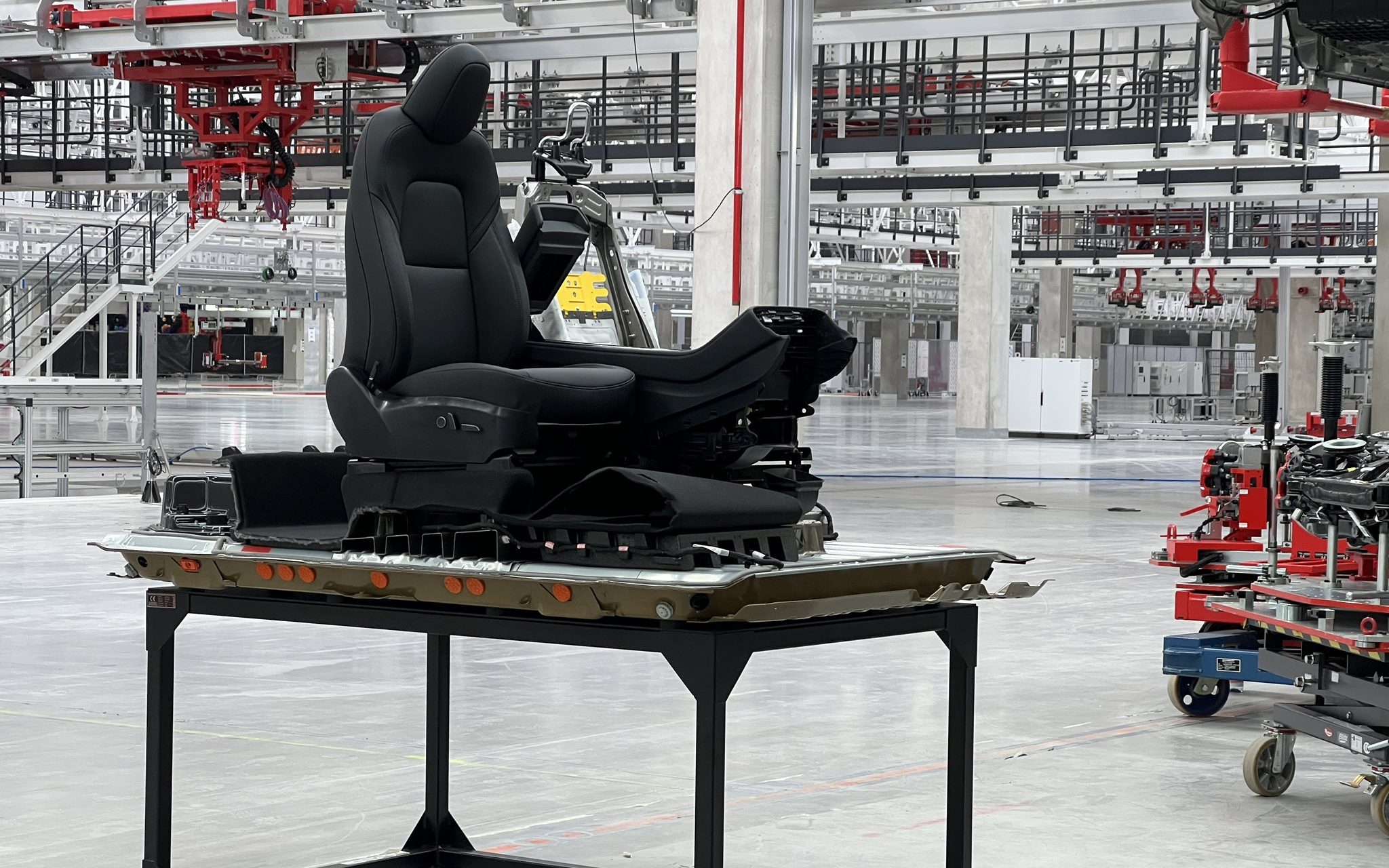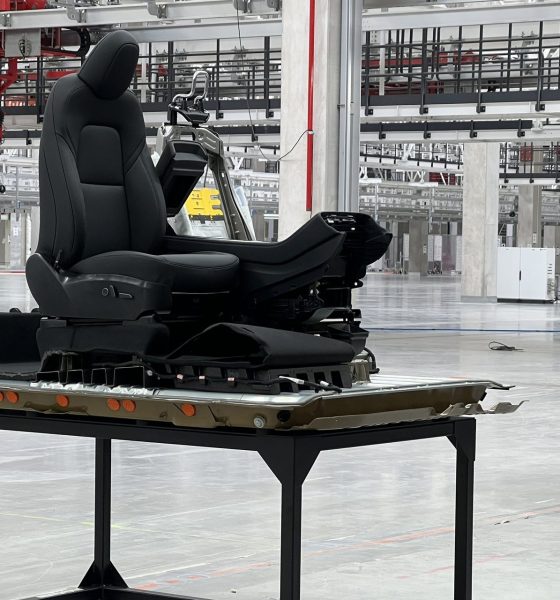

News
Tesla Giga Berlin’s Model Y seats to be mounted directly on 4680 structural battery
The substantial amount of savings that would result from Tesla’s use of structural battery packs was highlighted recently at the company’s “Country Fair” in Gigafactory Berlin. As shared by some of the event’s attendees, Tesla featured some exhibits in its factory tour which showed the Model Y’s seats being directly mounted on the vehicle’s structural battery pack.
Tesla featured two Model Y seats in its exhibit, one without cushions and another being finished. Both seats were directly placed on a battery pack. Tesla investor Adam Berg noted that he was able to speak with some of the company’s high voltage and process engineers, and he was reportedly informed that final production Model Y from Giga Berlin would indeed be mounted on the vehicle’s structural battery.
Such an update might seem quite minor, though it bodes well for the company’s manufacturing efficiencies. Mounting the Model Y’s seats into the vehicle’s battery would likely allow Tesla to reduce the parts needed to make the all-electric crossover while making production even more optimized for automation. With lesser parts, the assembly of the Model Y could be accomplished faster, and the buildout process could be less prone to errors.
On a lighter note, the Model Y seats’ exhibit at Giga Berlin’s Country Fair suggests that lumbar support for the all-electric crossover’s front passenger seat might be making a comeback. This is quite an interesting observation from attendees of the recently-held program, as the component was removed from Tesla’s US-made Model 3 and Model Y earlier this year. Following the removal of the component for the passenger side, Musk noted that vehicle logs showed very few actually used the feature.
Giga Berlin’s Country Fair featured several interesting exhibits from Tesla, though it is evident that the company’s 4680 cells and structural battery packs practically stole the show. With Tesla being very secretive about its 4680 cells and its structural battery packs, it was quite great to see the company showing off some real-world models for its upcoming technology. And considering the images that have been shared from the Giga Berlin Country Fair, it seems that Tesla is definitely taking strides towards becoming one of the world’s most efficient automakers, bar none.
Tesla seems intent on building its next generation of vehicles on the structural battery pack model. During the Q&A section of the Q3 2020 earnings call, Elon Musk told Jefferies analyst Philippe Houchois that Tesla would be moving away from the skateboard platform that it practically pioneered with the Model S. He also stated that the company would be moving fully to a new breed of vehicles that utilize structural batteries. Musk likened Tesla’s structural batteries to how modern aircraft in the way that they store fuel in their wings.
“The early rockets and aircraft, they had a separate aeroshell from the propellant tanks or fuel tanks, and then they realized that doesn’t make sense. And you’ve got to integrate — you’ve got to have your fuel tank in wing shape. You’ve got to have your propellant tanks in the shape of the body of the rocket, for example. You don’t want to put a box on a box, basically,” Musk said.
Don’t hesitate to contact us with news tips. Just send a message to tips@teslarati.com to give us a heads up.

News
Tesla FSD fleet is nearing 7 billion total miles, including 2.5 billion city miles
As can be seen on Tesla’s official FSD webpage, vehicles equipped with the system have now navigated over 6.99 billion miles.

Tesla’s Full Self-Driving (Supervised) fleet is closing in on almost 7 billion total miles driven, as per data posted by the company on its official FSD webpage.
These figures hint at the massive scale of data fueling Tesla’s rapid FSD improvements, which have been quite notable as of late.
FSD mileage milestones
As can be seen on Tesla’s official FSD webpage, vehicles equipped with the system have now navigated over 6.99 billion miles. Tesla owner and avid FSD tester Whole Mars Catalog also shared a screenshot indicating that from the nearly 7 billion miles traveled by the FSD fleet, more than 2.5 billion miles were driven inside cities.
City miles are particularly valuable for complex urban scenarios like unprotected turns, pedestrian interactions, and traffic lights. This is also the difference-maker for FSD, as only complex solutions, such as Waymo’s self-driving taxis, operate similarly on inner-city streets. And even then, incidents such as the San Francisco blackouts have proven challenging for sensor-rich vehicles like Waymos.
Tesla’s data edge
Tesla has a number of advantages in the autonomous vehicle sector, one of which is the size of its fleet and the number of vehicles training FSD on real-world roads. Tesla’s nearly 7 billion FSD miles then allow the company to roll out updates that make its vehicles behave like they are being driven by experienced drivers, even if they are operating on their own.
So notable are Tesla’s improvements to FSD that NVIDIA Director of Robotics Jim Fan, after experiencing FSD v14, noted that the system is the first AI that passes what he described as a “Physical Turing Test.”
“Despite knowing exactly how robot learning works, I still find it magical watching the steering wheel turn by itself. First it feels surreal, next it becomes routine. Then, like the smartphone, taking it away actively hurts. This is how humanity gets rewired and glued to god-like technologies,” Fan wrote in a post on X.
News
Tesla starts showing how FSD will change lives in Europe
Local officials tested the system on narrow country roads and were impressed by FSD’s smooth, human-like driving, with some calling the service a game-changer for everyday life in areas that are far from urban centers.

Tesla has launched Europe’s first public shuttle service using Full Self-Driving (Supervised) in the rural Eifelkreis Bitburg-Prüm region of Germany, demonstrating how the technology can restore independence and mobility for people who struggle with limited transport options.
Local officials tested the system on narrow country roads and were impressed by FSD’s smooth, human-like driving, with some calling the service a game-changer for everyday life in areas that are far from urban centers.
Officials see real impact on rural residents
Arzfeld Mayor Johannes Kuhl and District Administrator Andreas Kruppert personally tested the Tesla shuttle service. This allowed them to see just how well FSD navigated winding lanes and rural roads confidently. Kruppert said, “Autonomous driving sounds like science fiction to many, but we simply see here that it works totally well in rural regions too.” Kuhl, for his part, also noted that FSD “feels like a very experienced driver.”
The pilot complements the area’s “Citizen Bus” program, which provides on-demand rides for elderly residents who can no longer drive themselves. Tesla Europe shared a video of a demonstration of the service, highlighting how FSD gives people their freedom back, even in places where public transport is not as prevalent.
What the Ministry for Economic Affairs and Transport says
Rhineland-Palatinate’s Minister Daniela Schmitt supported the project, praising the collaboration that made this “first of its kind in Europe” possible. As per the ministry, the rural rollout for the service shows FSD’s potential beyond major cities, and it delivers tangible benefits like grocery runs, doctor visits, and social connections for isolated residents.
“Reliable and flexible mobility is especially vital in rural areas. With the launch of a shuttle service using self-driving vehicles (FSD supervised) by Tesla in the Eifelkreis Bitburg-Prüm, an innovative pilot project is now getting underway that complements local community bus services. It is the first project of its kind in Europe.
“The result is a real gain for rural mobility: greater accessibility, more flexibility and tangible benefits for everyday life. A strong signal for innovation, cooperation and future-oriented mobility beyond urban centers,” the ministry wrote in a LinkedIn post.
News
Tesla China quietly posts Robotaxi-related job listing
Tesla China is currently seeking a Low Voltage Electrical Engineer to work on circuit board design for the company’s autonomous vehicles.

Tesla has posted a new job listing in Shanghai explicitly tied to its Robotaxi program, fueling speculation that the company is preparing to launch its dedicated autonomous ride-hailing service in China.
As noted in the listing, Tesla China is currently seeking a Low Voltage Electrical Engineer to work on circuit board design for the company’s autonomous vehicles.
Robotaxi-specific role
The listing, which was shared on social media platform X by industry watcher @tslaming, suggested that Tesla China is looking to fill the role urgently. The job listing itself specifically mentions that the person hired for the role will be working on the Low Voltage Hardware team, which would design the circuit boards that would serve as the nervous system of the Robotaxi.
Key tasks for the role, as indicated in the job listing, include collaboration with PCB layout, firmware, mechanical, program management, and validation teams, among other responsibilities. The role is based in Shanghai.
China Robotaxi launch
China represents a massive potential market for robotaxis, with its dense urban centers and supportive policies in select cities. Tesla has limited permission to roll out FSD in the country, though despite this, its vehicles have been hailed as among the best in the market when it comes to autonomous features. So far, at least, it appears that China supports Tesla’s FSD and Robotaxi rollout.
This was hinted at in November, when Tesla brought the Cybercab to the 8th China International Import Expo (CIIE) in Shanghai, marking the first time that the autonomous two-seater was brought to the Asia-Pacific region. The vehicle, despite not having a release date in China, received a significant amount of interest among the event’s attendees.








